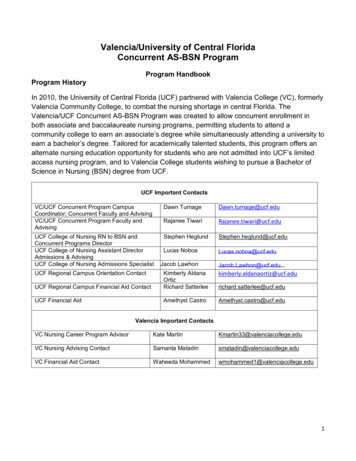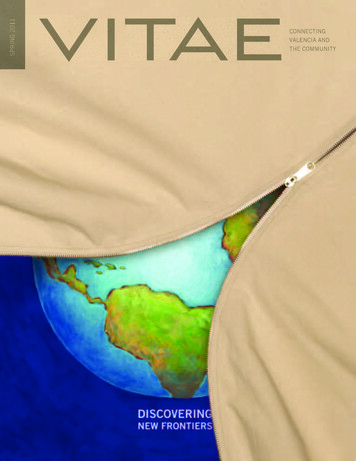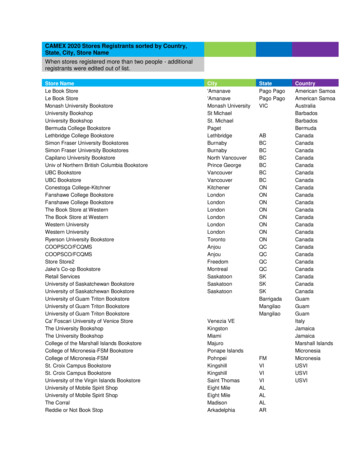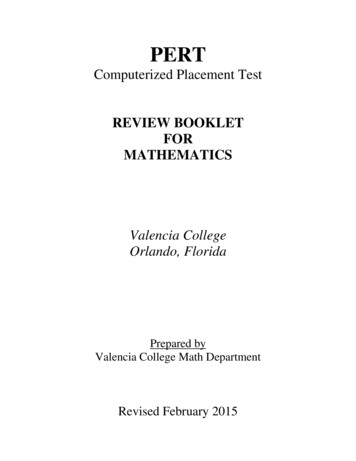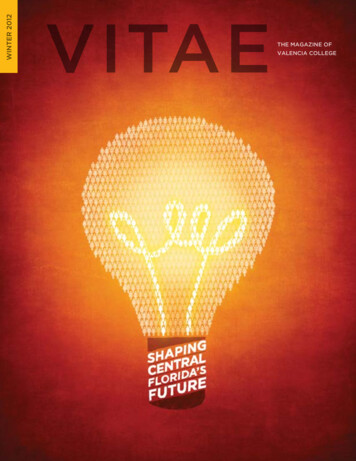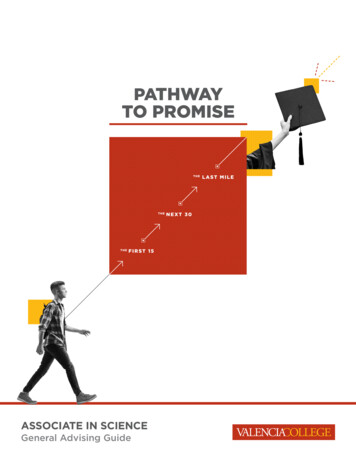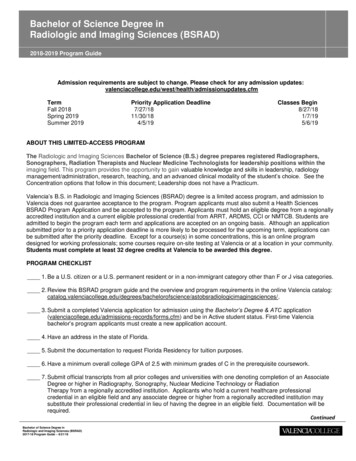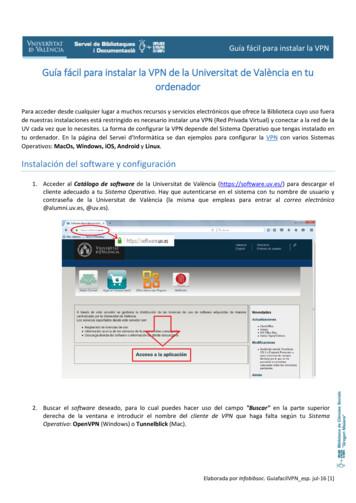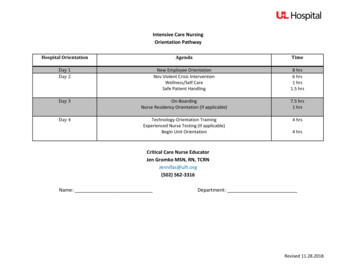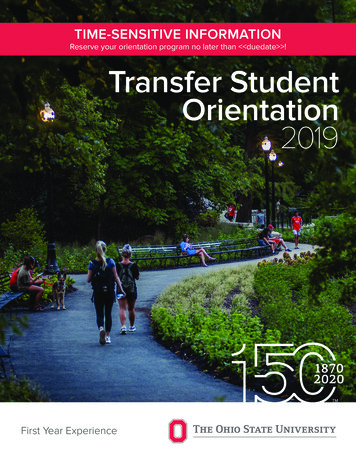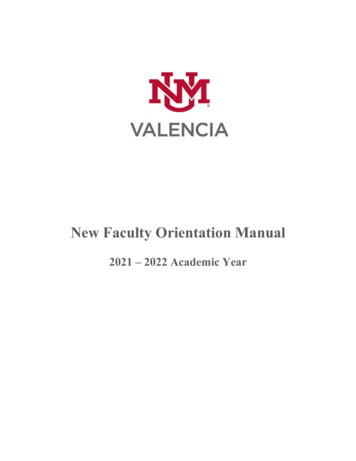
Transcription
New Faculty Orientation Manual2021 – 2022 Academic Year
A Welcome from the Dean of InstructionOn behalf of the faculty, academic support staff and students of UNM-Valencia, Iwelcome you to our campus. We are a teaching-centered institution, committed tofacilitating the learning outcomes and educational goals of our students. Ourcontinuing curriculum development is predicated on our collective goal to preparestudents to be leaders and contributors in the 21st century.This document is designed to provide accurate and useful information to help youunderstand our students, faculty, services, programs and processes. Morecomprehensive and detailed information concerning instruction at UNM-Valenciamay be found in the complete Instructional Council Policies and ProceduresManual and the UNM-Valencia Faculty Handbook. Please take the time tofamiliarize yourself with the information in this manual.If you have any questions or would like just to stop by, please don’t hesitate. Myoffice is A-114. You can reach me at 925-8601 or by calling the main number ofthe Academic Affairs Office, 925-8600.Sincerely,Dr. Laura MusselwhiteDean of InstructionProfessor of History
Table of ContentsBrief History of UNM-Valencia . 1The Role of a Branch Campus . 2Campus Vision and Mission. 2Vision Statement . 2Mission Statement . 2Programs and Services . 2Student Services . 3Other Programs and Services . 3Organizational Charts and Governance Structure . 4UNM’s Governance and Administrative Structure at UNM-Valencia . 4UNM-Valencia’s Extended Administrative Structure . 5Instructional Council Membership . 7UNM-Valencia’s Faculty Governance . 8Student Demographic Information . 9Faculty Roles and Responsibilities . 9Types of Faculty . 9Faculty Responsibilities . 10Applying for a Teaching Position . 14Adjunct Office . 15Cancelling a Class . 15Managing Classroom Enrollments . 15Accessing MyUNM and LoboWeb . 15Access Lobo Web . 16To access and print a class list . 17To create an Excel worksheet from your class list . 17To drop students . 17To enter grades . 18Enrollment Authorization –During the Term . 18Grades Issued to Reflect Completion/Achievement. 18Grades Issued to Reflect Non-Completion . 19Getting Clerical Assistance . 21Academic Affairs Hours of Operation . 21Closed Class Enrollment/Disenrollment Procedures . 22
Getting Computer Assistance . 22Preparing a Course Syllabus. 22Duplicating Documents (and how to reduce) . 25Creating and Accessing Your UNM Email Account . 25Referring a Student for Equal Access Services . 26Learning About Decisions on Inclement Weather . 26Getting Instructional Equipment Assistance . 26Getting Keys to Classroom Podiums . 26Children in the Classroom . 27Accessing Materials and Services in the Library . 27Scheduling a Make-Up Exam (or exams for online courses) . 27Getting Paid . 28Getting a Parking Permit . 29Enrolling in Performance Improvement Workshops (including technology) . 29Enrolling in Physical Fitness Programs . 29Getting Professional Development Funds . 29Calling Campus Police . 29Purchasing Items . 30Requesting Software Installation . 30Student Course Evaluations . 30Dealing with Student Issues . 30Getting a Teaching Approval. 33Ordering Textbooks . 33Ordering Instructor/Desk Copies . 33Getting Tuition Remission . 34Referring a Student for Tutorial Assistance . 35Campus Map .Error! Bookmark not defined.7Contact Information . 38Appendix A (FERPA) . 39Appendix B (Enrollment Authorization) . 41Appendix C (Net ID Set-Up Instructions) .42
Brief History of UNM-ValenciaThe University of New Mexico (UNM) began serving the educational needs of Valencia Countyin August 1978 with the establishment of the UNM–Eastern Valencia County Satellite Center.The creation of this Satellite Center ended nearly two decades of work by members of the LosLunas and Belén school districts to provide a stable source of post-secondary education andvocational training in Valencia County. A total of 93,000 in seed money was raised to helpopen the facility.In 1979, the State Legislative Finance Committee indicated that satellite centers, such as the onein Belén, should be established as branch campuses to be supported by an ongoing mill levy aswell as with student tuition and general fund appropriations.The local community indicated its continued support by voting overwhelmingly in favor ofcreating a branch campus. Additional assistance came from the Board of Educational Finance,the New Mexico State Legislature, and the Eastern Valencia County Higher EducationCommittee, Inc. As a result, a formal proposal to establish the branch was accepted by UNM inMarch 1981.Classes began in August of that year. Technical certificates and associate degrees could now becompleted locally for the first time in Valencia County history. Continued growth in enrollmentand program offerings soon created a pressing need for additional space and new facilities. Anew campus in Tomé was built in response to this need, opening its doors in the summer of1986.A Library and Learning Resource Center were added in 1994. Extensive renovations in thespring of 1995 provided additional classroom and office space, and the completion of the StudentCommunity Center in the spring of 2000 added additional classrooms, office space, and awellness/fitness center. In the spring of 2005, a new Health Sciences building opened up,providing a nursing lab, anatomy and physiology lab, allied health lab, presentation lecture hall,and four classrooms, two of which are equipped with student workstations.An ADN Nursing program began in 2010 and gained full ACEN accreditation in 2017. Manynew technical and academic programs have begun in the past five years, and UNM Valencia nowoffers thirty-five degrees and certificates.Currently, construction is underway for Valencia’s first off-campus site, the Workforce TrainingCenter. Credit and non-credit courses and training opportunities will be available at the center,starting in spring semester 2022.Page 1 of 46New Faculty Orientation Manual
The Role of a Branch CampusThe University of New Mexico (UNM) has established branch campuses to serve the citizens ofNew Mexico more fully and provide the highest quality of education for students pursuing postsecondary education at different locations throughout the state. Branch campuses respondspecifically to the unique needs and multi-cultural backgrounds of their respective communitiesby offering community education programs, career education (including certificate and associatedegree programs), and transfer programs that prepare students for upper-division entry into fouryear colleges and universities.Branch campuses utilize many resources in their service districts and therefore function asintegral parts of their surrounding communities. They are thoroughly committed to assisting inthe economic development of their service areas.The UNM branch campuses are considered fully-integrated component colleges. They arecommitted to serving the needs of their respective communities in the manner of acomprehensive community college, offering a variety of academic, career, and communityservice programs. The branch campuses pledge themselves to protect the quality and integrity ofall academic curricula, and the main campus pledges its resources, whenever appropriate andpractical, to the fulfillment of the varied missions of the branches. UNM’s Senior Vice Provostfor Academic Affairs has responsibility for establishing policies and procedures relative to allbranch operations, and oversight of branch campus affairs resides within the Office of theProvost.Campus Vision and MissionUNM-Valencia’s Strategic Plan is updated annually and revised as a whole every five years.The plan is available in its entirety at the following link: htmlVision StatementExcellence in teaching, learning, and service to our communityMission StatementA quality education – a lifetime of successPrograms and ServicesIn order to fulfill its mission as a branch campus, the University of New Mexico–Valencia offersfour types of educational programs:1. Certificate programs are offered in: 3-D Printing, Architectural Drafting Technology, ArtStudio, Automotive Technology, Business Administration, Digital Media Arts,Education, Emergency Medical Services, Film Technician, Game Design and Simulation,Page 2 of 46New Faculty Orientation Manual
Health Information Technology, Information Technology, Networking and Linux,Nursing Assistant, Personal Care Attendant, PC Operating Systems, Phlebotomy,VMware, and Welding. While many of these are designed as career technical, and nottransfer programs, some or all credits earned through these programs may be eligible fortransfer.2. Associate’s Degrees are offered in the fields of Architectural Drafting Technology, ArtStudio, Business Administration, Computational Mathematics, Criminal Justice,Criminology, Digital Media Arts, Education, Emergency Medical Services, Game Designand Simulation, General Science, Health Education, Information Technology, IntegrativeStudies, Liberal Arts, Manufacturing, Mathematics, Nursing, and Pre-Engineering.Credits in the General Science program can be applied to bachelor’s degree programs inNursing, Dental Hygiene, Radiography, Nuclear Medicine Imaging, Physical Therapyand Physician’s Assistant at the UNM Main Campus. Many of the credits earned forthese degrees can be transferred to the UNM Main Campus or to most other four-yearcolleges and universities.3. Developmental or Remedial Studies/Basic Skills assistance is offered so that studentswho are not adequately prepared for admission for college-level study can work toimprove their skills and meet their educational goals. Remedial courses are offered inEnglish and mathematics. Services for free basic skills, employability skills, high schoolequivalency and college preparatory skills, English as a second language, and citizenshipare provided by the Next Steps: Adult Education Program, which houses a completelearning center. Tutorial services are available to all students on campus, includingstudents in these programs.Student ServicesAdvising, disability support, financial aid, mentoring, registration, and testing (including makeup testing) are among the services available through Student Services.Other Programs and Services Academic Affairs Office provides administrative and clerical assistance to faculty.Wellness Center addresses all aspects of wellness by providing education, exerciseactivities, and assistance in developing a healthy lifestyle.Teaching and Learning Center provides assistance to faculty with technology,instructional equipment and other teaching-enhancement programs.The Learning Commons provides tutorial assistance to our students.Page 3 of 46New Faculty Orientation Manual
Organizational Charts and Governance StructureUNM’s Governance and Administrative Structure at UNM-ValenciaUNM Board ofRegentsDr. GarnettStokesUNM PresidentDr. JamesHollowayUNM ProvostDr. Alice V.LetteneyChancellorDr. LauraMusselwhiteDean ofInstructionPage 4 of 46Hank VigilRick GoshornDirector,Student ServicesDirector, BusinessOperationsNew Faculty Orientation Manual
UNM-Valencia’s Extended Administrative StructureDr. Alice LetteneyChancellorJon LechelPublic InformationVACANTJohn BollwegSr. Manager, Grantsand ContractsInstitutional ResearchRick GoshornDirector, BusinessOperationsJohn umanResourcesBrianKillingerPoliceLieutenantHank VigilDirector, StudentServicesMaisie BacaJoshua OwenManager, FinancialAidTest AdministratorPage 5 of 46Tracy rViridiana GarciaManager,Upward BoundStacie KirtleyManager,TRiONew Faculty Orientation Manual
Laura MusselwhiteDean of InstructionAndre BirdWellness Center ManagerSoledad Garcia-KingTeaching and LearningCenter DirectorTina HiteAcademic DivisionsJoseph PooleHealth Sciences ChairJustin BendellHumanities ChairNext Steps: AdultEducation ManagerElaine ClarkMath, Engineering, andComputer Science ChairMelanie SanchezDinwiddieScience and WellnessChairStephen TakachBusiness Admin.CoordinatorLaura MusselwhiteJulia SoSocial Sciences ChairBarbara LovatoPatricia GillikinLibrary DirectorWriting Center Director
Instructional Council MembershipThe Instructional Council is composed of supervisors within the instructional area. Thefollowing are the Instructional Council members (in alphabetical order, along with their emailaddress, and positions): John Abrams, jeabrams@unm.edu, Manager, Technology Support Margaret Anaya, murtiaga@unm.edu, Unit Administrator, Academic Affairs Office Justin Bendell, jbendell@unm.edu, Chair, Humanities Andre Bird, anbird@unm.edu, Manager, Wellness Center Cheryl Bryan, cbryan@unm.edu, President, Faculty Assembly Robert Castillo, rcastillo45@unm.edu, Academic Technical Analyst II Elaine Clark, ewclark@unm.edu, Chair, Mathematics, Engineering and ComputerScience Division Eileen Davis, eileend@unm.edu, Program Specialist, Allied Health Frances Duran, fduran@unm.edu, Branch Campus Registrar Nancy Engler, englern@unm.edu, Coordinator, Pre-Engineering Rita Garcia, rgarcia18@unm.edu, Recruiter and Manager, Dual Credit Program Soledad Garcia-King, sgking@unm.edu, Director, Teaching and Learning Center Patricia Gillikin, gillikin@unm.edu, Coordinator, English and Writing Center Director Jerry Godbout, jgodbout@unm.edu, Coordinator, Sciences Sarah Heyward, sheyward@unm.edu, Coordinator, Fine Arts Tina Hite, tinan@unm.edu, Manager, Next Steps: Adult Education Center Barbara Lovato, bllovato@unm.edu, Director, Library Laura Musselwhite, lmusselwhite@unm.edu, Dean of Instruction Joseph Poole, jrpoole1@unm.edu, Chair, Health Sciences and Director, Nursing Program Ariel Ramirez, aramirez8@unm.edu, Coordinator, Developmental Mathematics and theMathematics Center Veronica Salcido, verosalcido@unm.edu, Project Director, Title III R2S2 Grant Melanie Sanchez-Dinwiddie, melasanc@unm.edu, Chair, Science and Wellness Division Julia So, juliaso@unm.edu, Chair, Social Sciences Division Stephen Takach, set@unm.edu, Coordinator, Business Administration Alexa Wheeler, alexa08@unm.edu, Coordinator, HumanitiesTina Zuniga, zunigat@unm.edu, Supervisor, PASOS Student SuccessThese individuals constitute the Instructional Council (IC). The IC is an Advisory Board to theDean of Instruction in all matters that pertain to instruction. It is also a forum for the exchangeof information. All major decisions in the instructional area are made by the IC in conjunctionwith the Faculty Assembly in a process of shared governance.Page 7 of 46New Faculty Orientation Manual
A summary of roles is as follows: Dean of Instruction serves as the campus’ Chief Academic Officer. All instructional andinstructional support departments (as illustrated in the chart) report directly to the Dean.Division Chair: Division chairs at the Valencia Branch are very similar to academicchairs at the main campus and are subject to the same governing policies. The primarydifference between a division and a department chair is that the former oversees multipledepartments and disciplines. Their duties and responsibilities include: Preparation of the schedule of classes for the division (plus subsequent additions orcancellations) Development of curriculum Supervision of faculty Approval of faculty to teach certain courses (credentialing) Mentoring of faculty and serving as the point of contact for faculty issuesDivision Manager: A division manager has similar responsibilities to that of a divisionchair with the difference that it is a twelve-month position, specifically hired for thestated duties, and not subject to the same selection process and terms in office as that ofchairs.Program Coordinator: Program coordinators assist their respective division chair ormanager by assuming various responsibilities for specific programs under the supervisionof their chair, including scheduling, curriculum development, and evaluation of faculty.Except in specific instances as delegated by the division chair or manager, programcoordinators are not responsible for supervising division faculty or staff.Program Manager: Program managers assist their respective division chair or managerwith supervision of a major area or program within the division. As such, these aregenerally twelve-month positions. As is the case with coordinators, program managersare responsible for curriculum development, but are also responsible for supervisingfaculty and staff in their respective areas of responsibilities.More detailed descriptions of the duties and responsibilities of faculty administrators can befound in the Instructional Council Policies and Procedures Manual.UNM-Valencia’s Faculty GovernanceUNM-Valencia has a Faculty Assembly (as opposed to a Faculty Senate). In effect, all UNMValencia faculty are voting members of the Faculty Assembly.Faculty Assembly officers (what is generally referred to as the “FEC” – Faculty ExecutiveCommittee) include: PresidentVice-PresidentSecretaryArts and Sciences RepresentativeBusiness and Technology RepresentativePage 8 of 46New Faculty Orientation Manual
Faculty Assembly meetings are generally held on a monthly basis during the academic year.For more information regarding the Faculty Assembly, please visit the Faculty Home Page ces/index.html or the UNM-Valencia FacultyHandbook Home Page at s/facultyhandbook/handbook-pdf.html.Student Demographic InformationEverything we do is for the benefit of students. And to better serve our students we need to betterunderstand our students.The following is a brief profile of our student body, as of academic year 2020-2021: Mean age: 24 Ethnicity: 64% Hispanic, 22% White, 4% American Indian,1% African-American, 1% Asian/Pacific Islander, 3% Two or more races, 5% Unknown Sex: 63% female and 37% male Economic: 66% of students received a Pell grant Largest majors (of students who have declared a major): 32% in General Science, 13% inIntegrative Studies, 12% in Liberal Arts, 10% in Education (including ElementaryEducation and Early Childhood Education), and 7% in Business Administration. Of theseand other majors, 85% of students are in academic programs and 15% are in technicalprograms Preparedness: 55% of entering freshmen require at least one developmental studiescourse as preparation for college-level work.Faculty Roles and ResponsibilitiesUNM-Valencia is a teaching institution. That is what we are all about—teaching and learning.But we all know that what goes on in the classroom is but one element of teaching and learning(albeit the most focused and directed aspect of it).The information in this section is derived from any of the following documents and issummarized here for your convenience: UNM Administrative Policies and Procedures Manual,UNM Faculty Handbook, Instructional Council Policies and Procedures Manual, and UNMValencia Faculty Handbook.Types of FacultyFaculty expectations (i.e., responsibilities) are contingent on the type of appointment. The UNMFaculty Handbook describes four different types of faculty appointments in Section B3.1 asfollows:Page 9 of 46New Faculty Orientation Manual
B3.1 TYPES OF FACULTY APPOINTMENTS(a) Faculty appointments may be probationary, tenured, continuing non-tenure-track, ortemporary. Prior to awarding of tenure, tenure-track faculty appointments are probationaryappointments; following the award of tenure, such appointments are tenured. All facultymembers holding probationary appointments at the rank of assistant professor or above areeligible for consideration for tenure. (For a definition and discussion of tenure, see Sec. 4.7.1and Appendix I.) Non-tenure-track appointments do not lead to tenure. However, thepresumption with continuing non-tenure-track appointments is that they will be continued ifthe faculty member is not duly notified to the contrary. Non-tenure-track appointments wherethere is not a presumption of continuation are temporary.The following is a summary of the four types of appointments:1. Tenured: The term “tenured” indicates that after the expiration of a probationary period,faculty members should have permanent or continuous tenure, and their services shouldbe terminated only for adequate cause.2. Probationary: The term “probationary” is synonymous with “tenure-track.” These arefaculty who, if successful, will achieve tenure in a period of six years while serving at therank of Assistant Professor.3. Continuing Non-Tenure-Track: The term “continuing non-tenure track” refers to facultywho are issued annual contracts but who have “expectation” that their contracts will berenewed for the subsequent year. These faculty generally carry the rank of Lecturer (I, IIor III, depending on highest degree and other criteria).4. Temporary: The term “temporary” refers to faculty who are hired for one or two termswith no expectation of being hired beyond the current term of appointment. Temporaryfaculty are generally designated as “adjunct” faculty. Adjunct faculty are hired on asemester-by-semester basis on a competitive process. There are also one-year (i.e., twoterms) temporary assignments on a full-time basis. These appointments are usually madein the interim period between the retirement or resignation of a continuing facultymember.Faculty described in #1, #2 and #3 above will be designated as “continuing” faculty.Faculty ResponsibilitiesRegardless of appointment type, all faculty are responsible to:1. Treat students with dignity, respect and the highest expectations. Regardless of their age,college students are considered to be adults (in loco parentis is no longer the legalstandard) and should be treated accordingly. This means four things:a. Students are responsible for their own actions, including both maintainingappropriate behavior and meeting all requirements for the course as described inyour syllabus.b. Students have a right to privacy. If a student is eighteen years of age or older,FERPA (Family Educational Rights and Privacy Act) guarantees that no otherperson (parent, spouse, etc.) can have access to their educational record withoutPage 10 of 46New Faculty Orientation Manual
their consent. If you are ever unsure of what information to divulge to a personother than the student about that student’s educational record, rather than providethe information yourself, please direct the person to the Dean of Instruction(925.8601) or the Registrar (925.8585). Please find additional information aboutFERPA regulations here: http://registrar.unm.edu/privacy-rights/ferpa.html and inAppendix A.c. To avoid violations of FERPA rules. Do Not: At any time user personally identifiable information (UNM ID#, name, etc.) ina public posting of grades. Link the name of a student with that student’s UNM ID# in any publicmanner. Leave graded tests or homework in an unsecured area for students to pick up.These items can be left at the Academic Affairs Office for student pickup. Circulate a printed class list with student names and UNM ID# or grades as anattendance roster. Discuss the progress of any student with anyone (including parents) other thanthe student without the consent of the student. Provide anyone with lists of students in your classes for any commercialpurpose Provide anyone with student schedules or assist anyone other than Universitypersonnel in finding a student on campus.d. Students should not be spoken to in a condescending or patronizing manner, justas you as a faculty member should not be spoken to in such a way. Nor shouldstudents be derided in front of others. As far as possible, if a student needs to becorrected or an issue addressed (e.g., class work, behavior), the matter should beaddressed in private.e. Expect your students to succeed. It has been shown that high expectations(realistic ones, of course) from the instructor translate into higher achievement bystudents.2. Teach assigned courses. Faculty are assigned to teach courses by their division chair.
Credits in the General Science program can be applied to bachelor's degree programs in Nursing, Dental Hygiene, Radiography, Nuclear Medicine Imaging, Physical Therapy and Physician's Assistant at the UNM Main Campus. Many of the credits earned for these degrees can be transferred to the UNM Main Campus or to most other four-year
